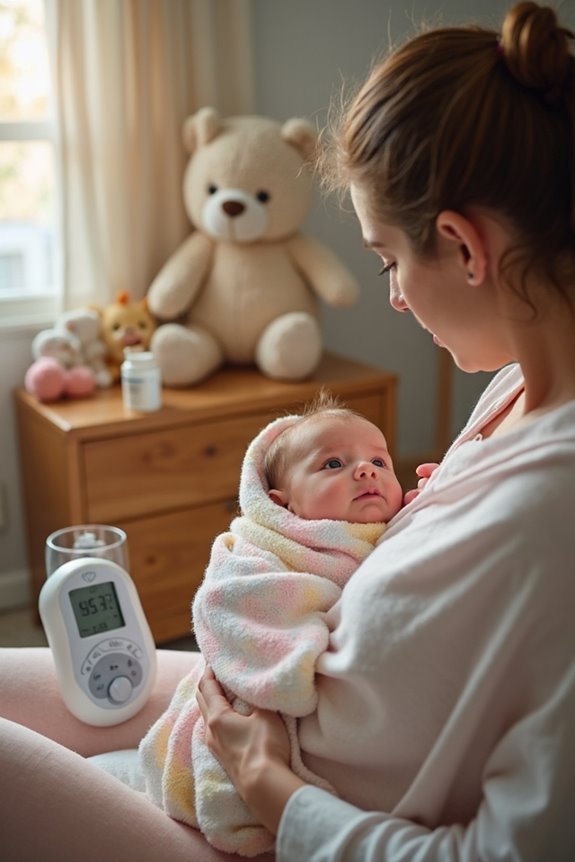When it comes to knowing when to take your baby to the hospital for a fever, there are key signs and risk factors to consider. We should always seek medical attention if an infant under three months has a fever exceeding 100.4°F. Look out for symptoms such as rapid breathing, irritability, and poor appetite. If your baby seems unusually fussy or lethargic, it’s best to consult a healthcare provider. Exploring these signs further can help guide your actions.
Key Takeaways
- Take infants under 21 days with any fever immediately to the hospital.
- Seek immediate care for babies under three months with fever over 100.4°F.
- Hospitalize infants 0-28 days with fever ≥ 38.0°C (100.4°F).
- Prolonged fever lasting over 48 hours requires hospital evaluation.
- Recurrent fevers persisting for a week need medical attention.
Recognizing Fever in Infants
How can we tell when a baby has a fever? Recognizing fever symptoms in infants involves observing their behavior closely. We might notice changes like fussiness or sleep disturbances. Babies may become unusually sleepy, less active, or irritable. Pay attention to physical signs, too.
- Flushed Skin: If their skin feels warm or flushed, it’s a common indicator.
- Rapid Breathing: Increased breathing rate coupled with frequent crying can signal a fever.
- Poor Appetite: A sudden disinterest in feeding is another clue.
These changes in infant behavior, combined with symptoms like blotchy skin or shivering, help us identify a fever. Trust your instincts and monitor these signs. If you’re concerned, a thermometer can provide clarity, and consulting a doctor ensures safety.
Understanding Age-Specific Risk Factors

Understanding age-specific risk factors is crucial when assessing the severity of a fever in infants. We need to consider age stratification as a key part of our risk assessment. For instance, babies under 28 days are more vulnerable to serious infections. Premature birth and low birth weight can also heighten risks, making early medical intervention essential.
Let’s break it down:
- 0-21 days: Highest risk; immediate medical attention is vital.
- 22-28 days: Still high risk; close monitoring is required.
- 29-60 days: Moderate risk; watch for symptoms.
Other factors include prolonged NICU stays or complex medical histories, which increase infection risks. Recognizing these specifics helps us take proactive steps, ensuring our little ones get the care they need promptly. Remember, when in doubt, seek medical advice.
The Importance of a Thorough Physical Examination

A thorough physical examination is a cornerstone in evaluating a baby’s health when fever strikes. We must embrace a detailed physical assessment, using examination techniques that ensure we don’t miss crucial signs. Here’s what we focus on:
- Temperature Measurement: Rectal readings give us the most accurate insights.
- Vital Signs: Monitoring heart rate, breathing rate, and blood pressure paints a picture of your baby’s condition.
- General Appearance: Observing for distress or lethargy can indicate severity.
- Respiratory and Cardiovascular Evaluation: Catching abnormalities early is key.
- Neurological Status: Reflexes and mental alertness tell us a lot.
Identifying High-Risk Conditions

When it comes to fevers in infants, identifying high-risk conditions is crucial for ensuring their safety and well-being. We need to pay close attention to factors like premature birth and the infant’s medical history. Premature infants, born before 37 weeks, are more vulnerable to invasive bacterial infections. Babies with a complex medical history or prolonged NICU stays also face increased risks.
Let’s remember that infants under three months with a fever over 100.4°F require immediate care. Other high-risk factors include:
- Prolonged Fever: Lasting over 48 hours.
- Recurrent Fevers: Persisting for a week or more.
- Recent Hospitalization: Increased susceptibility to infections.
Key Diagnostic Tests and Their Significance

Even though it can be worrying to see your infant with a fever, knowing the key diagnostic tests can help us take the right steps towards understanding what’s going on. Let’s explore their diagnostic significance and some essential laboratory protocols:
- Blood Tests: A Complete Blood Count (CBC) and Absolute Neutrophil Count (ANC) offer insights into infection severity. Blood cultures are crucial for detecting bacteremia.
- Urine Analysis: Urinalysis and urine culture confirm urinary tract infections, while leukocyte esterase indicates infection.
- Cerebrospinal Fluid (CSF) Analysis: CSF culture and cell count help diagnose meningitis.
- Imaging: Chest X-rays and ultrasounds assess respiratory and urinary issues, respectively.
Evaluating Inflammatory Markers

Understanding the significance of diagnostic tests can guide us toward the right decisions for our little ones. Evaluating inflammatory markers like C-Reactive Protein (CRP) and Procalcitonin (PCT) is crucial in determining the nature of a fever. With high biomarker significance, PCT offers excellent diagnostic accuracy for invasive bacterial infections, especially in infants. Here’s why these markers matter:
- CRP and PCT: Essential for distinguishing bacterial from viral infections.
- Procalcitonin: Recommended for infants 22 to 60 days to assess bacterial infection risk.
- Thresholds: CRP >20 mg/L, PCT >0.5 ng/mL indicate significant inflammation.
Guidelines for Hospital Admission by Age

Deciding when to take your baby to the hospital for a fever can be daunting, but understanding the age-specific guidelines can make this process easier for all of us. Hospital admission decisions vary by age:
- Infants 0-28 Days: High-risk for serious bacterial infections. With a fever ≥ 38.0°C (100.4°F), they’re generally admitted for evaluation and treatment. Babies under 21 days are almost always admitted.
- Infants 29-60 Days: They might be considered low-risk if they meet criteria like negative urinalysis and normal blood markers. If no infection source is identified, they could be discharged.
Clinical judgment and tools like the PECARN rule guide decisions. Remember, these age guidelines help ensure our babies get the best care when needed.
Special Considerations for Ill-Appearing Infants

When our little ones seem unwell, it can be especially concerning, and knowing when to seek hospital care is crucial. Ill-appearing infants, those showing signs like irritability, lethargy, or poor feeding, need our full attention. These may signal underlying issues like focal bacterial infections, particularly in babies with complex medical histories or who were born prematurely.
- Risk Factors:
- Premature infants’ immature immune systems increase infection risks.
- Fever without a clear infection source requires vigilant infection monitoring.
- Diagnostic Criteria:
- Tests like CBC, blood cultures, and CSF analysis help identify serious infections.
- Management:
- Broad-spectrum antibiotics and supportive care are essential.
- Close monitoring ensures timely adjustments in treatment.
Hospital admission is often necessary to manage these risks effectively.
Monitoring and Managing Fever at Home

Caring for a baby with a fever at home can feel daunting, but with some simple strategies, we can manage it effectively. First, we need to focus on fever management. Regularly monitor the baby’s temperature using a reliable thermometer. If the fever lasts less than two or three days, it’s typically manageable. Remember, hydration’s importance can’t be overstated—offer frequent fluids to prevent dehydration.
- Dress them in lightweight clothing and keep the room cool.
- Use lukewarm baths to gently lower the fever.
- If the baby is over three months, acetaminophen can help, but consult a healthcare provider first.
We should also watch for signs like irritability or lethargy, which might indicate it’s time to seek medical advice.
Frequently Asked Questions
What Home Remedies Can Help Reduce a Baby’s Fever Naturally?
We can try gentle herbal remedies and soothing sponge baths to naturally ease a baby’s fever. Let’s use chamomile or lavender after consulting our doctor, ensuring the water’s lukewarm and calming for our little one’s comfort.
How Can I Differentiate Between Teething and Fever Symptoms in My Baby?
Let’s navigate this parenting maze together. Teething signs, like drooling and gum pain, whisper gently, while fever signs, like high temperature and chills, shout. Trust your instincts, and if fever’s present, reach out to healthcare professionals.
Are There Specific Foods to Avoid When My Baby Has a Fever?
Let’s avoid spicy foods and opt for cooked fruits to soothe our baby’s fever. We’ll stick to gentle, easy-to-digest options. It’s essential we nurture them with love and care while monitoring their comfort and symptoms closely.
What Should I Do if My Baby Refuses Fluids During a Fever?
When our baby refuses fluids during a fever, let’s offer hydration options like diluted apple juice or oral rehydration solutions. It’s crucial for fever management. We should monitor closely and ensure they’re comfortable and hydrated.
How Long Can a Fever Last Before I Need to Worry?
Imagine our little one’s fever lasts over three days—it’s time to worry. Fever duration beyond this, especially with other symptoms, signals a need for medical advice. Let’s always trust our instincts and seek help when needed.





